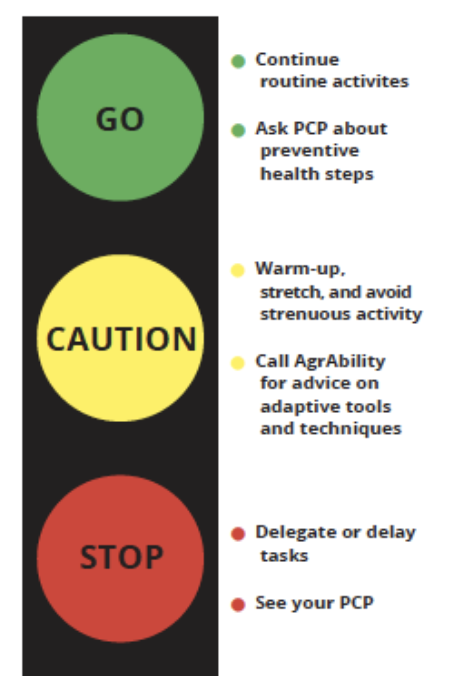by Brie Weisman, Maine AgrAbility
Aches and pains seem just as much a part of farming as seeds and soil, whether we work with hand tools, or spend long hours sitting on a tractor. Farming can be demanding work, with tasks and hours that simply do not respect the traditional 9-to-5 work model.
Many farmers adopt a “grin and bear it” attitude toward pain and weariness, accepting regular, even chronic, pain as part of the job description, or perhaps simply as the cost of keeping with the hard work of farming into old age. Certainly, stiffness and discomfort are an occasional hazard of any strenuous work, but there is a difference between soreness from overwork and pain. Soreness is easily, naturally recovered from by resting the muscles involved. A farmer who routinely ignores soreness will eventually experience pain. Living with daily pain from farming is unnecessary, and creates an opportunity for injuries both temporary and permanent, something costly both to the farmer personally and to the farming enterprise. Discomfort and pain are part of our bodies’ warning systems to slow down or stop altogether and address an issue. When we understand them and heed them, they are as useful as a tractor gauge with clearly marked green, yellow and red zones.
Taking the time and effort to understand these warning signs is critical. Imagine farmers treating their other tools in this manner. Imagine farmers operating tractors long after their oil gauges read low, or after their temperature gauges pointed into the red. Imagine your astonishment at hearing that the farmer did not think it worth their time to learn what these gauges meant, or that ignoring them would not be catastrophic.
To help farmers identify varying levels of soreness and pain and address them, Maine AgrAbility has developed “Managing Pain on the Farm: A Tool for Farmers.” This tool, available through the Maine AgrAbility website, employs the concept of the traffic light.

A green light is self-explanatory: When you are pain-free and discomfort-free, you have a “green light” to proceed with work as usual. The differences between the yellow light and red light are more subtle.
A “yellow light” is a signal to slow down, proceed with caution and be prepared for the possibility of stopping. Soreness, stiffness, and muscle fatigue are the most common yellow light issues. Repetitive motions and new activities (or the first time engaging in an activity during that season) can lead to yellow-light symptoms. They are generally not dangerous in themselves, but ignoring them can lead to increased discomfort the next day (we’ve all woken up stiff and sore from the previous day’s work) and prolonged recovery time. As we get older, we naturally find ourselves spending a bit more time in the yellow zone. Issues such as arthritis, amputation, stroke and many others may contribute to a farmer finding themselves in the yellow zone faster than they’re used to.
It is important to realize that stiffness and fatigue can both in themselves lead to accidents or injuries. Addressing these symptoms may mean something as simple as taking a short work break or a stretch break, or figuring out a way to use different muscles for the same job, like shifting from right-handed to left-handed shoveling or raking, or changing from gardening bent over to working on your knees. Schedule permitting, it is better still to leave that task entirely for a while in favor of another task that employs different muscle groups.
Sometimes when we’re driving, we’re lucky enough to pass under a yellow light without having to stop for the red. This is also a goal of the pain management tool; acknowledging these symptoms and attending to them responsibly means you may avoid many red lights. Some, unfortunately, are inevitable. Meeting a red-light pain condition means just what a red traffic light means: stop now, for safety’s sake. Remember, a healthy farm needs a healthy farmer.
Red-light issues include pains generally described as sharp, stabbing, burning, aching, throbbing or searing. Anything that causes you to wince, yell out or gasp is generally a red light, as is a pain that causes you to guard the area. Most of us will naturally feel inclined to stop work at this point, or at least move on to other work that does not elicit the pain response. But there are people with high thresholds for pain, high levels of stubbornness, and people who just feel they have to get a job done (and farming seems to attract more than its fair share of these types!).
This is precisely the moment to remember that your body is both your most valuable and most irreplaceable tool. Sticking it out for that last hour of the day, tolerating a sharp pain in your shoulder every time you raise your arm or other acts of gritty tenacity may actually be doing additional damage. And remember that thinking about a searing pain you are enduring means that you’re not fully thinking about whatever tool or machinery you may be operating, increasing the risk of accident or a costly, and avoidable, mistake. Lastly, stopping work immediately or as soon as possible is not only safer, it often means a faster recovery. Red-light issues other than basic twists and sprains should always be discussed with your primary care provider. Not treating these injuries seriously and quickly can mean a longer recovery time, and more time away from farming.
We understand that addressing chronic pain and other physical challenges is sometimes complicated and may require specialized equipment. To help yourself or your agricultural workers in Maine address these challenges, contact Maine AgrAbility to learn about site visits, alternate techniques and adaptive equipment. For more information on the tool outlined above, visit Maine AgrAbility online or contact us at [email protected] or 207-944-1533.
